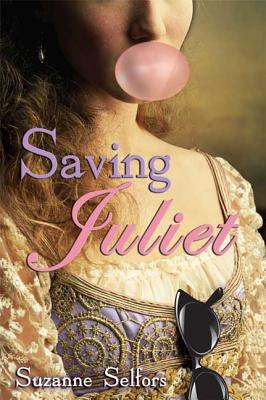Have you ever seen the movie Lost in Austen, about the girl who falls though this crack in her bathroom wall into Jane Austen's Pride and Prejudice only to swap places with main character, Elizabeth Bennet? No? Well, make sure you do. It's lengthy, but worth it.
If you have seen the movie, you know things in fictional P&P Land start tripping up the moment Amanda steps a toe in it, and everything goes wonky.
Suzanne Selfors's Saving Juliet gives Shakespeare's classic Romeo and Juliet the same sort of treatment, and with thoroughly fastasmagoric results.
Seventeen year old Mimi, scion of the late, great theatre goddess Adelaide Wallingford and last hope for the historic Wallingford Theater hates acting, despite her pedigree and promise on the stage. As any teen faced with but one choice of futures, Mimi chafes against the strictures, plans, and outright momentum of her mother, who--from Mimi's viewpoint, only wants to live out her own failed dreams through her daughter. Complete with a stuck-up Surfer boy pop-star (for the ratings,dear) co-star in the form of one Troy Summer, avaricious understudies, and an heretofore unexperienced case of stage fright, Mimi does her best to play Juliet Capulet until she can escape for a few weeks in a planned vacation with her Doctors Without Borders-esque aunt.
Enter some very realistic and intuitive descriptions of Mimi's pre-cue panic attacks--which just keep getting worse, her inital crush on and being crushed by Troy Summer, and finally a magic charm which send Mimi and Troy both either back in time, or arguably, into an alternate universe wherein the feud between Montague and Capulet is alive and thriving.
Reading this book is a bit like seeing all the different charcters on days other than those Shakespeare chose to write about. Selfors gives great back-story about how the feud began, manages to humanize Juliet as a real thirteen-year-old girl, no matter the era, makes the reader totally buy Paris as a pervy old man, keeps Romeo from sounding like the most fickle guy alive, and eventually even makes heroes of many unheroic characters, and while the "script" often strays from Shakespeare's narrative (Romeo and Juliet never fall in love at all, at least possibly until after the book), and the language stays mostly contemporary, the book is all the better for these choices. Elizabethan English--as genius as Will's abilities were--would only have cluttered the alternate plot points and would have seemed almost gaudy in comparison to the very real and very ageless way Selfors handles the story.
This is definitely a book in which the cover does the story a disservice. While Mimi is very much a modern teenager, she isn't flippant or blase, which is what that pink bubble-gum bubble and kitten shades say to me. Mimi has heart, just like her (normally) fictional counterparts, and that should be shown, too.
I got a kick out of this book with it's nimble narrative and ultimate happy ending. I engaged with it, and if I hadn't gotten it from my library in the first place, I'd have been happy with my choice to BUY it.

No comments:
Post a Comment